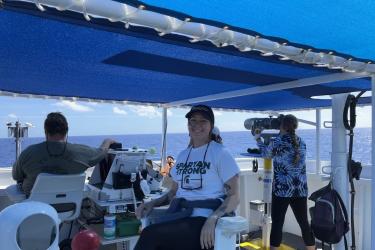![3422x2460-SetteatSea.jpeg]()
NOAA Ship Oscar Elton Sette sets sail. Photo: NOAA Fisheries/Ali Bayless.
The NOAA Ship Oscar Elton Sette set sail Tuesday, August 13th, to pick up our field camp biologists. They have spent the summer researching Hawaiian monk seals and sea turtles in the Northwestern Hawaiian Islands. The Sette will travel the entire Hawaiian Archipelago, covering over 1,500 miles from Hawaiʻi Island to Kure Atoll. You can follow this journey on our story map.
In the Papahānaumokuākea Marine National Monument, the Sette team will also conduct projects that help protect the delicate environment of this special place.
Field Research Camps
Every year, NOAA’s Pacific Islands Fisheries Science Center establishes camps to study Hawaiian monk seals and Hawaiian green sea turtles in the Northwestern Hawaiian Islands. We count animals, mark them with flipper tags or numbers on their fur or shells, and perform life-saving interventions. Monk seal biologists rescue seals from entanglements and treat infected wounds. Sea turtle biologists save nesting females which become entrapped, collect priceless samples for genetic studies, monitor the temperature of nests, determine the success of hatchlings emerging from nests, and track the movement of the nesting beach sand over the season. After three months out in the field, these biologists are going to appreciate hot showers and cold ice cream when they embark the Sette!
![Science field camp at Pearl and Hermes Atoll.]()
The field camp at Pearl and Hermes Atoll, where four researchers have spent their summer. Photo: NOAA Fisheries/Ali Bayless.
Seal and Turtle Surveys
Some islands are suitable for seals and turtles but not for field research camps. The Sette will stop at these sites along their way to survey for both species. Single-day surveys will be conducted at:
These brief stops provide crucial data on the small but important seal populations that use these islands. This year, the turtle team plans to survey Niʻihau Island in hopes of seeing tracks created by females indicating that they use this island for nesting; this is especially important information to obtain after the loss of the Honu’s main nesting location, East Island in French Frigate Shoals.
![Researchers on a vessel conducting monk seal survey.]()
Researchers conduct monk seal survey along the rugged coast of Nihoa. Photo: NOAA Fisheries/Ali Bayless.
Seal Rehabilitation
Life as a juvenile monk seal can be hard. Malnutrition leads to the death of young seals, a key limitation to recovery of the population. During the field camp season, biologists observe and assess the condition of the seals. If necessary, the Sette will bring struggling juvenile seals onboard. We then transport them to rehabilitative care at The Marine Mammal Center’s Ke Kai Ola Monk Seal Hospital in Kona, Hawai‘i.
It is a long way to Kona, so the team onboard the Sette will keep busy caring for the seals and ensuring their safety during transit. Upon arrival to Ke Kai Ola, the seals will be nursed back to health. This will give them a second chance to thrive once they return to their home in the Northwestern Hawaiian Islands.
![Two monk seal pups resting on the shore.]()
On the left, is a healthy monk seal pup and on the right is a malnourished pup. Photo: NOAA Fisheries/Ali Bayless.
Ecosystem Observations
In order to fully understand the overall health of a species, we must also assess the health of the ecosystem. The Sette will collect ecosystem data throughout the cruise using a Conductivity-Temperature-Depth (CTD) instrument. The CTD measures temperature, salinity, oxygen, and other nutrients from the surface to depth to characterize the habitat. The team will also be retrieving and re-deploying a High-frequency Acoustic Recording Package (HARP) to monitor cetacean acoustics in the Northwestern Hawaiian Islands.




